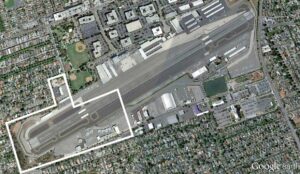
SMO — Whether you're on Team 2023 or Team 2015, it's unlikely that the Santa Monica Airport will close entirely anytime soon, city officials said in a recent report.
The Federal Aviation Administration (FAA) has long maintained that its agreement with City Hall extends through at least 2023, while city officials say it ends July 1, 2015.
But even City Hall acknowledges that planes will likely be touching down at the airport on July 2 of next year.
If City Hall attempted a full closure, lawsuits from FAA and aviation advocates could last a decade or more, city officials said in a report to City Council.
In Chicago, city officials said, the mayor ordered the bulldozing of an airport runway during the night.
"Some suggest that the FAA has no significant legal authority to control or punish such an action," they said.
However, city officials continued, the proposal is unrealistic as the situation was different in Chicago. For one thing, the FAA would likely seek an injunction and — while the legal situation is sorted out — City Hall would be responsible for any accidents that occurred as a result of the changes.
Some nearby residents have long complained about the noise and pollution caused by propellor planes and jets using the airport. Others claim that SMO poses a safety hazard with the edge of the runway being located only a few hundred feet from homes.
Last year, City Hall sued the FAA, attempting to determine who would control the airport following next year's expiration of a 1984 agreement but a judge threw the case out stating that, among other things, the suit was premature given the fact that council has not yet declared its intent to close the airport. They have until April 14 to file an appeal.
City Hall's recent report lists recommendations for next steps to be considered at councils' meeting on Tuesday, including studying the feasibility of a partial closure, halting the sale of fuel, rezoning the land around the runways, and refusing to extend leases to flight schools.
A 35-acre portion that City Hall is calling the Western Parcel was not transferred as part of a1948 agreement that the FAA claims obligates the space to be used as an airport in perpetuity. For this reason, city officials said, the plot could theoretically be closed next year.
The shorter runway, they said, would build a buffer between residents and the landing area. It would also reduce problems for residents, they said, because "the shorter runway would impact airport usage." Essentially, larger, faster jets would be unable to land or takeoff.
An environmental clean-up may be required given that fuel has been stored under the airport for more than 50 years, officials said. Council could halt or curtail the sale of fuel by lessees, handing the responsibility over to City Hall. The Airport Commission recently voted to send its own recommendation to council, suggesting an outright ban on fuel sales.
The airport land is currently unzoned and city officials are suggesting that they consider starting the process of zoning the area and "asserting traditional local control over the future land uses."
Given the need to keep revenues high enough to cover the cost of operating the airport, city officials are recommending that five-year leases be offered to non aviation tenants and one-year leases be offered to aviation tenants.
Flight schools, however, could be on the chopping block after the 1984 agreement expires next July. City officials are recommending a leasing policy that would eliminate or condition the schools because their "operations create significant and detrimental noise impacts on surrounding neighborhoods and afford a minimal benefit to the community."
City Hall plans to complete an appraisal of the airport properties in the next few months. This will allow them to charge market rates when leases expire next year.
If council does decide to take back some or all of the land, city officials said, the array of potential reuses is "staggering."
One resident group, Airport2Park, wants the space to be turned into a park, drawing funds from bonds, donations, state and regional grants, and lease revenues from the businesses on the north side of the airport. City officials acknowledged that the city by the sea is "underparked" but noted that it's too early to say whether or not funding will be available.
Others, they said, have suggested residential and commercial development in the area with a focus on affordable housing.
dave@www.smdp.com









